Topical decongestants, produced in the form of nasal dropsare capable of causing an addictive effect. Complex therapy with the use of medications, surgical intervention and physiotherapy allows you to get rid of addiction.
Record content:
- 1 What leads to the development of addiction to nasal drops?
- 2 What groups of drops are addictive?
- 3 Which nasal sprays and drops are not addictive?
- 4 Symptoms of medication rhinitis
- 5 The mechanism of development of addiction
-
6 How to get rid of medication rhinitis?
- 6.1 Therapeutic addiction treatment
- 6.2 Addiction treatment with physiotherapy treatments
- 6.3 Folk remedies
- 6.4 Addiction Surgery
- 7 How to restore the mucous membrane after giving up drops?
- 8 Complications of medication rhinitis if untreated
- 9 Video about addiction to nasal drops
What leads to the development of addiction to nasal drops?
Irrational use of topical decongestants, which is not due to therapeutic necessity, causes an uncontrolled vasodilation effect. It is manifested by excessive relaxation of smooth muscle tissues in the walls of arterioles - small capillaries that permeate the nasopharyngeal cavity.
Violation of the natural vascular tone causes swelling of the epithelial covering of the respiratory lumen. This condition is called rhinitis medicamentosa. Topical decongestants contain active compounds that stimulate epinephrine receptors in their chemical formula.
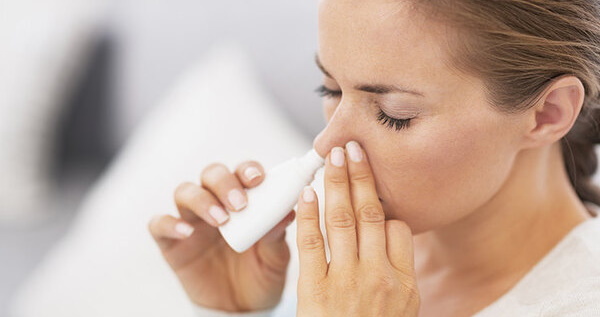
Addiction to nasal drops (get rid of a neglected pathological condition associated with atrophic or hypertrophic changes, it is possible only by an operative method) develop against the background tachyphylaxis. This is a specific physiological response that reduces the therapeutic effect.
Stimulants of adrenergic receptors cause narrowing of the nasopharyngeal arterioles. With prolonged use of topical decongestants, the natural regulation mechanism of adaptive expansion and contraction of the bloodstream is turned off. The body assigns this function to adrenergic receptor stimulants.
Addiction and the need for a constant increase in dose arise when the recommended regimen for taking nasal liquid or aerosol solutions is not followed. The frequency of use of such drugs is increasing. The vascular channels stop expanding and narrowing without drug stimulation.
What groups of drops are addictive?
The effect of addiction and tachyphylaxis is provoked only by drugs containing substances that interact with adrenaline receptors. Diffusion of such components of the medicinal composition into the mucous membrane of the nasal sinuses causes irritation of sensitive biological elements of types α1 and α2.
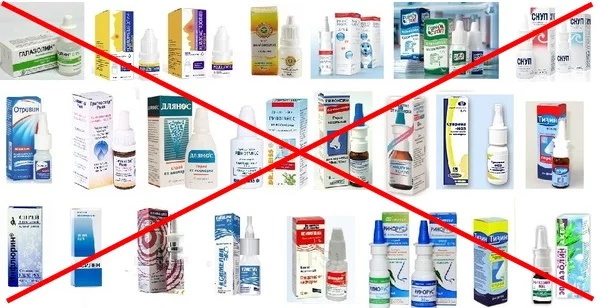
They are localized in arterioles in large numbers, which aggravates the tachyphylaxis effect and forces the patient to constantly increase the dosage with uncontrolled self-medication. With the development of drug dependence, the period of narrowing of the bloodstream and a decrease in the permeability of their walls is reduced.
Elimination of puffiness and relief of nasal breathing does not last long. Then the next dose is needed. The habituation process develops imperceptibly for the patient. Especially often those who independently try to treat allergic, colds or infectious rhinitis get into drug addiction.
Typical symptoms of such pathological conditions:
- sinus congestion;
- nasal voice;
- labored breathing;
- copious secretion of mucus.
The most popular and affordable drugs in the pharmacological category of topical decongestants, causing addiction and tachyphylaxis.
Table:

| Name | Pharmacological properties |
| Nazivin | A synthetic drug for the symptomatic treatment of acute diseases of the respiratory system. Facilitates nasal breathing, reduces swelling of the mucous membrane, suppresses mucus secretion, and prevents bacterial complications. |
| Sanorin | Has vasoconstrictor and anti-congestive properties. The addictive effect is caused by the active ingredient - naphazoline nitrate. Refers to the pharmacological group of α2-adrenergic agonists. |
| Galazolin | Narrows the blood lumens in the lining of the sinuses. Relieves hyperemia and reduces pathological exudation. Addiction provokes the active component xylometazoline, which acts as an antagonist of α2-adrenergic receptors. |
| Naphtizin | Vasoconstrictor drops, actively used for the treatment of diseases of the ENT organs and during rhinoplasty. |
| Tizine | It has vasoconstrictor and decongestant properties. An effective stimulant of adrenaline receptors. |
| Rinonorm | Favorably affects the condition of the epithelial coating. The drug has decongestant and antihyperemic properties. |
| Knoxprey | Aerosol medication for topical application in ENT practice. It has a pronounced anti-edematous and vasoconstrictor effect. |
Addiction to nasal drops (you can get rid of addiction with the help of corticosteroids, having the opposite effect) cause drugs from the pharmacological group of antagonists α2-adrenergic receptors. Such drugs have the effect of narrowing the arterioles and anti-edema properties.
Which nasal sprays and drops are not addictive?
Modern medicines on a steroid basis are devoid of factors for the development of drug dependence, which is due to the mechanism of their pharmacological action. They are suitable for long-term use and are well tolerated by most patients.
These drugs include:
-
Avamis. A hormonal decongestant drug with increased affinity for adrenaline and glucocorticosteroid receptors.
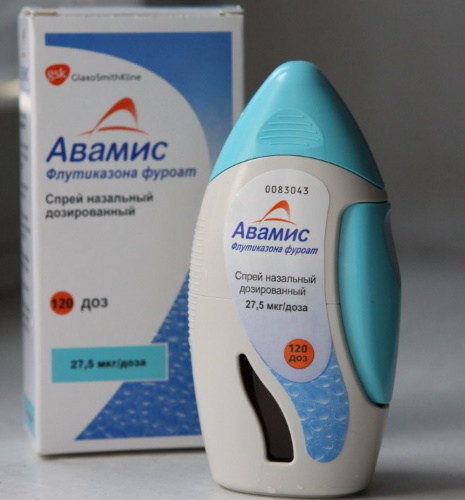
- Flix. Nasal drops with a pronounced anti-inflammatory effect based on mometasone furoate.
- Nazonex. Intranasal glucocorticosteroid, which does not cause systemic side effects and does not provoke the development of drug-induced rhinitis. Has a decongestant and antihistamine effect.
- Polydexa. Bacteriostatic and vasoconstrictor nasal drops. They have a pronounced anti-inflammatory effect and reduce exudation.
- Baconase. Antiallergic medicine that relaxes smooth muscles without an addictive effect. It significantly improves the parameters of external respiration.
Intranasal corticosteroid drugs have powerful effects. Before using them, be sure to consult with an otolaryngologist.
Symptoms of medication rhinitis
An important signal of drug dependence is an increase in the frequency of drug use throughout the day. After another dose of drops or spray, sinus congestion and difficulty in breathing quickly return.
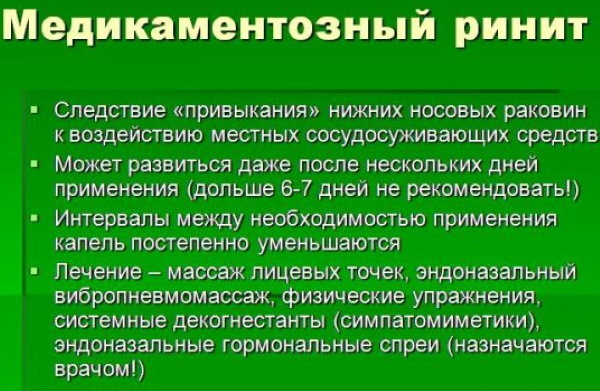
The patient constantly feels:
- itching and burning in the area where the medicinal solution is installed;
- cephalgic manifestations of a pressing nature, which is associated with changes in intracranial pressure;
- psychoemotional lability;
- irritated condition of the larynx;
- violation of olfactory perception;
- general discomfort in the body.
Typical symptoms of drug dependence on nasal drops include a permanent runny nose, accompanied by activation of cough and sneezing reflexes. In the severe stage of addiction, chemical damage to the epithelial layer of the sinuses is observed.
The arterioles cease to adequately perceive the next dose of the drug, its effectiveness decreases, tachyphylaxis manifestations develop.
For a severe form of drug-induced rhinitis, the following are characteristic:
- periodic nausea;
- increased headaches;
- suppression of appetite;
- disturbances in circadian rhythms;
- increased heart rate;
- lethargy during the daytime;
- excessive nervous excitement at night;
- profuse lachrymation.
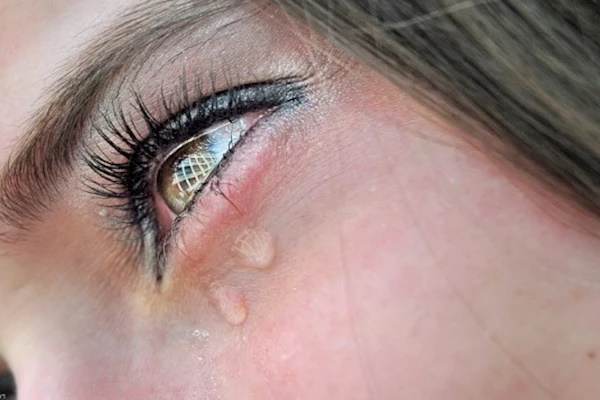
The most gentle and mild effect is possessed by intranasal preparations based on phenylephrine. They dilate the arteriolar lumen without significantly slowing the nasopharyngeal blood flow. The increased filling of the mucous membranes with hematological fluid causes their hypertrophy - pathological proliferation.
The mechanism of development of addiction
Drug disturbance of vascular tone with topical decongestants, frequent and excessive stimulation of adrenergic receptors cause insufficient blood filling of the epithelial cover. Tissue edema decreases, but the diameter of the choanas - the internal openings of the airways - increases.
It is sometimes possible to get rid of drug addiction provoked by excessive use of nasal drops with the help of traditional medicine recipes.
Before using non-traditional means, you must consult with an otolaryngologist so as not to worsen the condition.
Atrophic rhinitis medication develops as a result of suppression of the secretory activity of goblet cells, which produce mucus exudate. The constant increase in dosage inherent in drug dependence leads to the so-called rebound effect.

Its essence lies in the pathological reflex expansion of the arteriolar lumen after drug withdrawal. This leads to an increase in the permeability of the vascular walls, secondary tissue edema and a disorder of the secretory function of the nasopharyngeal glands.
How to get rid of medication rhinitis?
You can independently overcome the pathological condition only at the initial stage of its development. Treatment of advanced medication rhinitis involves the use of special therapeutic tactics, and with the proliferation of epithelial tissues - surgical intervention.
When the first symptoms of addiction are detected, you should immediately abandon the use of topical decongestants or replace the drug by choosing an analogue with another active ingredient. The principle of gradual weaning is to consistently reduce the dose and frequency of use. The medicine is diluted with saline or boiled and cooled water to a comfortable temperature.
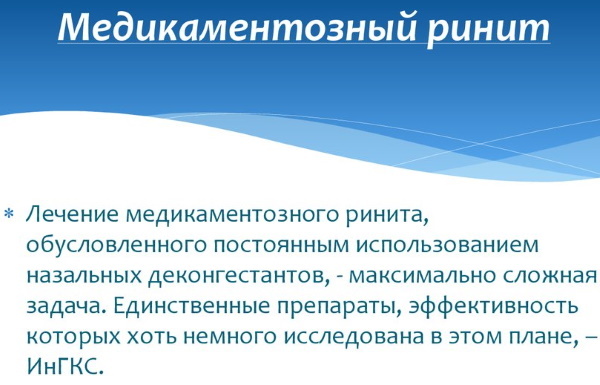
Gradually reduce the frequency of use of drugs and instill them in one nostril. Conscious control of one's own actions is necessary. With a sharp rejection of the use of vasoconstrictor drops, an even more significant volitional effort is required.
Replacing the drug used with an analogue with another active substance allows you to normalize nasal breathing and gradually get rid of addiction. Given the identical mechanism of action of all topical decongestants, this method does not always work.
It is important to overcome psychological dependence by making certain volitional efforts for this.
It usually takes 10-15 days of patience to restore the normal functioning of the sinuses.
Therapeutic addiction treatment
Conservative methods of treating rhinitis medication include the use of ascorbic and pantothenic acids, vitamins P and E. They strengthen the vascular walls, increase their elasticity and reduce permeability. Preparations containing such biologically active chemical compounds eliminate swelling of the mucous membranes and improve nasal breathing.
For toning arterioles, Dihydroquerticin is used - a dietary supplement that intensifies the blood supply to tissues and slows down the aging process of cells. Addictions to nasal drops (you can get rid of medication-induced rhinitis with Ascorutin) affect the work of the cardiovascular system, cerebral organ and lower respiratory tract.

Prescribe drugs that reduce the fragility of blood vessels and bronchodilators. In the complex therapy of rhinitis medicamentous include Cavinton or a similar medicine to stimulate cerebral circulation. In most cases, conservative treatment methods can eliminate the vasodilation that accompanies drug dependence.
In the absence of noticeable hypertrophy or atrophy of soft tissues, the use of anti-inflammatory drugs is considered sufficient, which effectively eliminate the swelling of the mucous membranes.
Medicines of this pharmacological category are selected that are not capable of affecting vascular tone. Therapy for rhinitis drug is accompanied by the appointment of topical decongestants on a corticosteroid basis. They are distinguished by their inability to be addictive and have a strong anti-inflammatory effect.
These drugs include:
- Rhinoclenil;
- Nasobek, additionally possessing antihistamine and immunosuppressive properties;
- Beclomethasone - inhaled bronchodilating aerosol;
- Fliksonase.
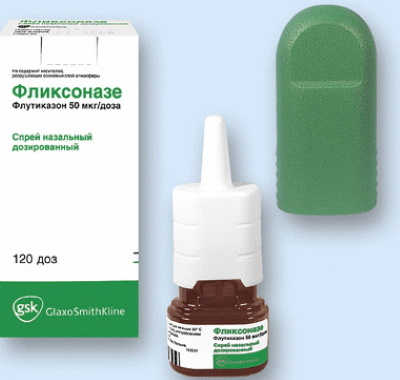
Hormonal agents for inhalation and intranasal use are contraindicated in fungal infections. Another category of drugs prescribed for rhinitis medication and drug dependence treatment is histamine receptor inhibitors.
They have an anti-allergic effect without affecting the work of sensitive adrenaline elements. Of this pharmacological group, for the treatment of addiction to nasal drops, the most popular are Sanorin, Levocabastin, Allergodil.
These drugs prevent the release of inflammatory mediators that block the nasal passages and cause swelling of the nasopharyngeal cavity. In the complex therapy of drug-induced rhinitis, washing saline solutions of hypertonic and isotonic types are standardly included. These are usually 0.9% sodium chloride liquids.
These include:
- Dolphin;
- Aqua Maris Strong is a natural preparation based on the water of the Adriatic Sea;
- Morenazal;
- Aqualor Forte.
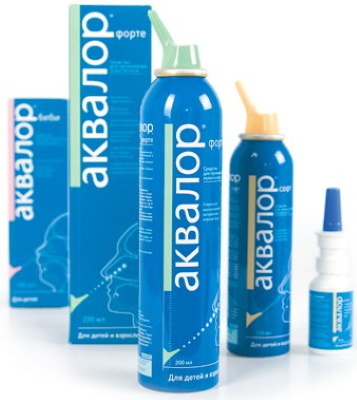
With such means, you need to rinse the sinuses 4-5 times a day for the entire period of complex therapy.
Addiction treatment with physiotherapy treatments
With significant dystrophic changes and suppression of the secretory function of the goblet cells, special hardware and manual methods of therapy are used. The tissues are exposed to laser radiation, acupuncture intervention, electrophoresis.
Such therapeutic technologies strengthen the vascular walls, restore the secretory activity of the nasal glands, and stop the symptomatic manifestations of drug-induced rhinitis. Effectively influencing transcapillary processes with laser radiation. The method has a positive effect on the ciliated epithelium, relieves inflammation and swelling.
Dependence on nasal drops (7-10 sessions of laser therapy allow you to get rid of vascular dystonia) can be lost with the help of Physiomer, No-Sol, Quicks and others moisturizing solutions. I use them in conjunction with physiotherapy procedures.
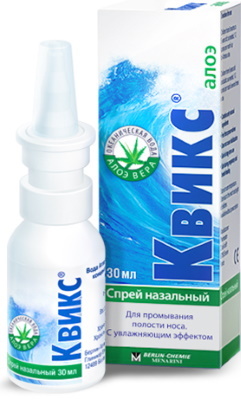
A course of acupuncture is prescribed, which is considered an effective way to eliminate medication rhinitis. Stimulation of physiologically active regional and segmental points improves the innervation reactions of muscle fibers in the area of acupuncture.
An effective method of treating otolaryngological disorders is electrophoresis - an instrumental procedure, providing for the supply of drugs into the nasopharyngeal lumen using a calculated current and voltage.
Use drugs based on:
- thiamine;
- panthenolic acid;
- inhibitors of histamine receptors;
- routine;
The method is not used in relation to patients with hematological pathologies and cardiac disorders. To reduce the discomfort during electrophoresis, anesthetic medications are used.
Positive dynamics is observed after 10-12 sessions. Physiotherapy procedures eliminate somatic disorders provoked by vasodilation and vascular dystonia, but cannot get rid of psychological dependence.
Folk remedies
Alternative medicine suggests using aloe juice drip solution.

A large leaf of a medicinal plant is squeezed out and diluted with boiled water in equal proportions. Such a composition should be instilled 3 times a day, 4 drops in each nostril.
At the initial stage of drug addiction, natural bee honey diluted with water helps. Such a folk remedy eliminates the tingling sensation in the sinuses and moisturizes the mucous membrane. Honey diluted in water should be injected into each nostril in 4-5 drops at intervals of 6-8 hours.
Addiction Surgery
A severe and advanced form of medication-induced rhinitis often requires surgery. Surgical methods are used when the respiratory function is difficult due to the pathological proliferation of tissues that reduce the lumen of the respiratory canals.
Use radio wave reduction, vasotomy, vaporization and other surgical techniques. Surgical intervention is performed with a scalpel or with the help of advanced minimally invasive medical technologies. The mucous membrane and soft tissues are partially removed.
Minimally invasive methods for eliminating drug dependence:
- radio wave coagulation;
- vacuum resection;
- ultrasonic disintegration;
- laser vaporization.

Such options for surgical intervention are preferable to surgical intervention with a scalpel, since they have a shorter rehabilitation period. In some cases, septoplasty is necessary - alignment of the nasal septum.
How to restore the mucous membrane after giving up drops?
Derinat, an immunomodulating drug, has a pronounced regenerating effect. Special washing solutions based on seawater are used. The restoration of the mucous membrane is facilitated by Pinosol, which contains oil components and extracts of medicinal herbs.
To reduce puffiness and suppress the inflammatory process in epithelial tissues, Rinitol Edas-131 is prescribed - a homeopathic remedy that accelerates the healing of damaged fibers. Washing with sea buckthorn or peach oil activates regenerative processes in cells.
Complications of medication rhinitis if untreated
Chronic swelling of the nasopharyngeal cavity develops. Drying out of the mucous membrane provokes destructive changes in soft tissues, deformation of cartilage and bones. In the absence of adequate treatment, regular nosebleeds and severe migraines are possible.
Abundant discharge of lacrimal secretion and activation of the sneezing reflex are observed. If you do not get rid of drug addiction provoked by the irrational use of nasal drops, complete loss of olfactory ability, severe snoring, and distortion of diction are not excluded. Severe respiratory failure develops.
Video about addiction to nasal drops
Addiction to nasal drops, how to get rid of what appears:



